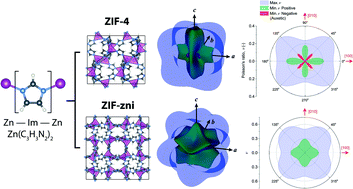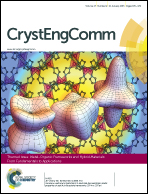Quantum mechanical predictions to elucidate the anisotropic elastic properties of zeolitic imidazolate frameworks: ZIF-4 vs. ZIF-zni†
Abstract
We use ab initio density functional theory (DFT) to elucidate the mechanical properties of two topologically distinct zeolitic imidazolate framework (ZIF) materials: ZIF-4 and ZIF-zni, both of which have the same chemical composition of Zn(Im)2 [Im = C3H3N2−] and are constructed from an identical Zn—Im—Zn basic building block. The CRYSTAL code was used to compute the single-crystal elastic constants Cij of the (orthorhombic) ZIF-4 and (tetragonal) ZIF-zni structures at the PBE level of theory. Through tensorial analysis of the Cij, we reveal the three-dimensional representation surfaces of the Young's modulus, shear modulus, Poisson's ratio and linear compressibility, which enable us to describe the detailed elasticity behaviour and to pinpoint basic crystal structure–property correlations. Notably, we discover that ZIF-4 can potentially exhibit a negative Poisson's ratio, thereby representing the first example of an ‘auxetic-ZIF’ to be identified to date. Furthermore, we show that our DFT predictions are consistent with recently reported experimental measurements of the Young's and bulk moduli of such complex ZIF structures.

- This article is part of the themed collection: Metal-Organic Frameworks and Hybrid Materials

 Please wait while we load your content...
Please wait while we load your content...